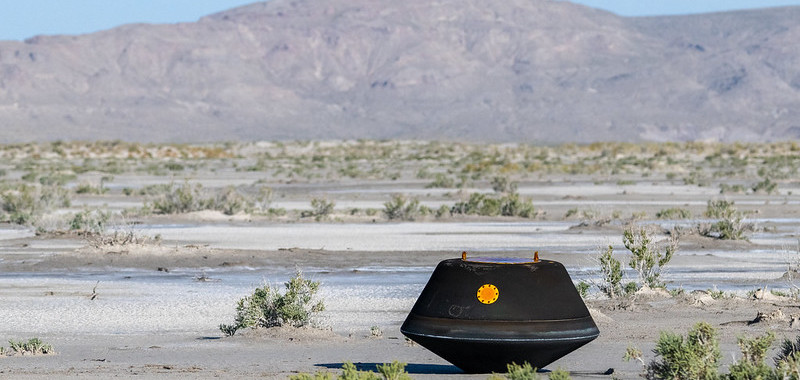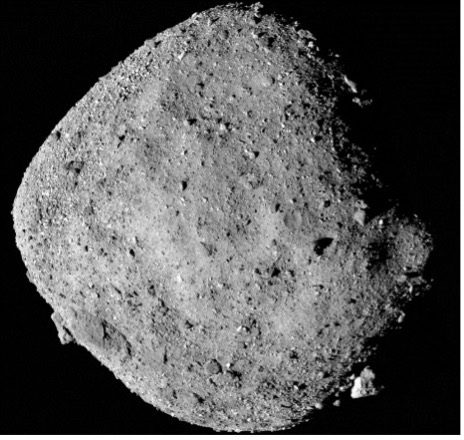
© NASA/Keegan Barber
On the 25th September 2023 NASA excitedly announced the successful return of a rock sample from the asteroid Bennu. This small package had travelled for two years over 2 million km and was heralded as containing scientific information which will help us to understand the origin of life. The technology and engineering involved in such a project is mind blowing but perhaps nothing compared with what is to come when the science is done. For me as a geochemist this project is hugely exciting for the suggestion is that maybe the seeds of life began, not on Earth, but in space. Further, as a Christian, is my faith big enough to contemplate that the precursors of life might be everywhere in the Universe, and that our inhabited planet is one of many?
Understanding the origin of life – the when, the where and the how – is still one of the big unanswered questions of science. Fifty years ago the famous astronomer Fred Hoyle and his colleague Chandra Wickramasinghe proposed that life did not begin on Earth at all but was delivered to Earth from space. At the time this idea did not gain traction in mainstream science and in fact was given ‘crank status’. Until, that is, the careful study of some meteorites some decades later gave the idea some plausibility, albeit in a more moderate form.
Visitors from space
Meteorites are rocks from space and they are several different types. One group in particular has engendered interest amongst scientists studying the early history of our solar system. These are a group of primitive meteorites known as carbonaceous chondrites – carbonaceous because they contain a high proportion of black, sticky organic material and chondrite because the other major component is made up of silicon-based material in the form of rounded grains known as ‘chondrules’. Careful analysis has shown that the black organic material originated in space and contains some complex molecules such as amino acids, known to be the building blocks of life. Hence there is the intriguing possibility that the starting materials of life on Earth were delivered from space, that is of course unless the samples were contaminated with earthly material on entry into our planet’s atmosphere.

Image of Asteroid Bennu 101955, from NASA
Asteroid Bennu
Fast forward to asteroid Bennu, proper name 101955 Bennu. Bennu is a micro-planet only a few hundred metres across derived originally from the Asteroid belt, a region of planetary rocky debris in orbit around the sun between Mars and Jupiter. Bennu is now on a different orbit around the sun having been dislodged at some period in its history and now, conveniently, comes relatively close to Earth from time to time. Asteroid Bennu is rather like a huge unconsolidated meteorite, made up of a rocky rubble, dust and carbonaceous material. It is extremely old, it is thought to have formed within the first 10 million years of the solar system, and is made up of the original materials of the solar system – the building blocks which 4.5 billion years ago were fused together to form our own planet Earth.
Pristine solar system material
In December 2018 NASA landed a spacecraft on Bennu and began making observations. In October of 2020 they collected a sample from the surface of Bennu. It is this ‘treasure’ that has now arrived. The reason why this material is so important is that, in contrast to its meteorite cousins, samples from Bennu have not suffered the trauma of unprotected entry into the Earth’s atmosphere and the associated potential for contamination. These rocky grains will therefore provide a much more reliable record of both the variety and the composition of the ‘space molecules’ of life.
Meanwhile, back on Earth
There is of course an alternative theory in which life began not in space but on Earth, and – perhaps you might guess given my scientific background – one which I find more plausible. There are doubts about whether molecules delivered from space could have both survived their journey into the Earth’s oceans and arrived in sufficient quantity to trigger the synthesis of life. Not that the terrestrial process is any simpler. We know that the early Earth was a ‘hellish’ place, in fact the earliest era of Earth history is known as the Hadean. Boiling oceans, meteorite or asteroid bombardment and abundant volcanic activity on the primitive Earth hardly make for a likely place to construct the complex and delicate molecules which were the precursors to life. However, the aqueous nature of the human cell and the distribution of trace elements in the human body provide some clues that our rocky, watery planet may have provided a home for the necessary chemical synthesis to taek place without the need to be kick-started from space. In addition, we have time on our side. The first indications of life on Earth may be as old as 3.7 billion years ago and are certainly as old as 3.5 billion years. Eight hundred million to a billion years is abundant time for complex life-forms to develop from simple beginnings.
Some difficult questions
Stepping back from the scientific debate, the Bennu mission leaves us with some puzzling questions. Is life on Earth unique? Or, could our planet be typical of many similar planets in the cosmos? Is biology simply a common property inherent in the life of all stars and their associated planets? Many would agree that life is a fundamental property of the Universe and that we are simply the product of a set of universal laws. So, get used to it they will say. But for others that is not a truly satisfying answer. Is the cosmos really that impersonal? Is there really no purpose to our existence? As a Christian I believe that there are more satisfying answers than the ‘get used to it’ argument implies. God invented biology and all of life, whether on our planet or beyond, for his enjoyment. Further, within the Christian worldview there is a very clearly defined purpose for us as individuals – that is to live in relationship with the God who brought all things into being.




